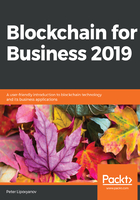
What this book covers
Chapter 1, Bitcoin, Blockchain, and Cryptoassets, introduces the reader to the content of the book. It gets the reader up to speed with the latest blockchain developments, including price action, and covers some exciting blockchain projects and use cases.
Chapter 2, A Brief History of Money, covers the definition, main functions, origins, and evolution of the concept of money from barter trade to commodities, gold standard, fiat, and finally digital and cryptocurrencies. It examines these concepts with some basic economic theory and historical examples to enable the reader to logically make sense of the current developments in digital and cryptocurrencies.
Chapter 3, The Birth of Bitcoin and the Advantages of a Decentralized Payment System, introduces the circumstances around the launch of Bitcoin and the chain of events and innovations that lead to its creation. It explains the advantages of using a decentralized system instead of a centralized system.
Chapter 4, Five Forces of Bitcoin – #1 Blockchain, introduces the five technologies driving Bitcoin, namely blockchain, cryptography, consensus algorithm, peer-to-peer network, and software code base. Then, it goes on to describe the blockchain technology in more detail.
Chapter 5, Five Forces of Bitcoin – #2 Cryptography, defines cryptography and describes its historical evolution and some key concepts that are relevant to Bitcoin and cryptoassets in general.
Chapter 6, Five Forces of Bitcoin – #3 Consensus Algorithm, discusses the heart of the Bitcoin blockchain, the Proof-of-Work consensus algorithm, which solved the double-spending problem in a decentralized way for the first time in history, and thus enabled the existence of decentralized payment networks.
Chapter 7, Five Forces of Bitcoin – #4 P2P Network, discusses Bitcoin's peer-to-peer protocol and network and the different types of nodes in the network, including full nodes, and SPV nodes.
Chapter 8, Five Forces of Bitcoin – #5 Software Code Base, discusses Bitcoin's software code base and its scripting language. Different types of wallets, blockchain explorers, and other applications are also presented. The chapter also discusses the programmability of Bitcoin, which enables features and decentralized applications such as digital asset registers, trade finance, and crowdfunding.
Chapter 9, How Ethereum Took the Idea of Blockchain to the Next Level, introduces Ethereum and its founder, Vitalik Buterin. The chapter discusses how it was launched, looks at its main features, and examines how it builds upon Bitcoin. Then it goes on to explain Ethereum's Turing-complete smart contracts and the Ethereum Virtual Machine.
Chapter 10, Ethereum – A Global Platform for Decentralized Applications, presents Ethereum's use case as a platform for decentralized applications with the help of some examples. Then it goes on to present Ethereum's crowdfunding aspect, again with examples. It also discusses Ethereum's bold vision of Decentralized Autonomous Organizations (DAOs).
Chapter 11, Blockchains Focused on Specific Sectors and Use Cases, presents some public blockchains focused on specific sectors or use cases, as opposed to general-purpose blockchain protocols such as Ethereum. Then it goes on to examine the potential impact of blockchain on the financial, consumer, and technology sectors.
Chapter 12, Corporate Blockchains, discusses the main private permissioned blockchain projects developed by and for large corporations. It describes the differences between this type of blockchain and the permission-less public blockchains discussed previously.
Chapter 13, The Disruptive Potential of Blockchain Technology, recaps the current state of affairs in the blockchain space and takes a look at the future potential of the technology.
Chapter 14, Blockchain and AI, discusses the intersection between blockchain and AI and some potential convergence points and use cases. What are the key advantages of blockchain and AI, and how can they be combined? The main thesis is that the convergence between blockchain and AI lies in the automation of tasks and entire business processes to increase productivity and efficiency in the future's shared economy.
Chapter 15, Current Issues and Potential Solutions to Take Blockchain to the Next Level, discusses the current challenges for blockchain technology, such as scalability, interoperability, governance, privacy, and regulation. Then it presents the set of solutions being developed to overcome these challenges and take blockchain to the next level and, potentially, mass adoption. Some of the main projects trying to develop next-generation blockchain technology are also presented.